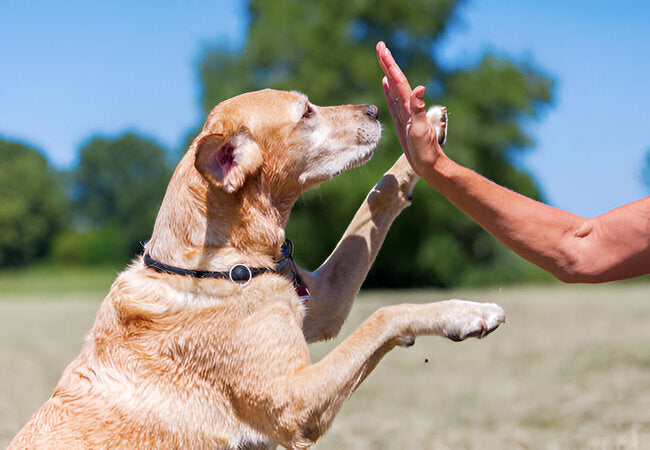4 Hand Signals You Can Teach Your Dog in 2025 – Vet‑Approved Training Guide 🐶🖐️

In this article
4 Hand Signals You Can Teach Your Dog in 2025 – Vet‑Approved Training Guide 🐶🖐️
By Dr. Duncan Houston BVSc
Whether your dog is far away, in a noisy environment, or growing older and losing hearing, hand signals are powerful tools for clear communication. In 2025, vets and behaviorists agree: combining visual cues with gentle guidance improves obedience, engagement, and safety. 🐾
1. 📏 Why Hand Signals Matter
- Dogs are keen visual learners and quickly pick up body language.
- They’re essential in noisy areas—like parks, trails, or busy streets—and for hearing-impaired or aging dogs.
- Hand signals are also silent and discreet—perfect for indoor training or crowded spaces.
2. 🖐️ Signal #1: Sit
Signal: Palm up, raise hand from chest to shoulder height, arm smooth and slightly forward.
How to teach: Lure with treat or wait for a natural sit. Mark “Yes!” when they sit with clean signal. Gradually omit lure, fade to hands-only.
Why it works: Simple gesture, instantly recognizable, reinforces calm posture.
3. 🕊️ Signal #2: Down
Signal: Palm facing down, move arm from shoulder to floor level in a sweeping motion.
How to teach: Lure from sit with treat, sweep down alongside body. Reward as they lie flat. Reduce treat guidance over repetitions.
Benefit: Encourages calm behavior and resets excitement—useful in public, vet visits, or meeting new people.
4. ✋ Signal #3: Stay
Signal: Arm extended forward at about chest height, palm facing the dog like a “stop” signal.
How to teach: Ask for sit/down, then give the stay signal. Reward for short hold and gradually increase the duration. Fade treat reliance.
Why it matters: Enables controlled pauses, helps manage dangerous situations, supports self-control in varied surroundings.
5. 🏃 Signal #4: Come
Signal: Arm extended down at your side with palm up, then sweep up toward your chest or shoulder.
How to teach: Pair verbal cue “come” with sweeping signal during recall training. Reward arrival. Shift focus to visual cue after repetition.
Key benefit: Provides reliable return—even at a distance or under distraction—supports off-leash control.
6. 🧠 Training Tips for Visual Communication
- Teach one signal at a time in a calm setting, then pair with treats for clarity.
- When combining with verbal commands, say cue after the visual—this prevents dependency on voice alone.
- Use consistent, exaggerated gestures until your dog clearly associates movement with behavior.
- Gradually reduce rewards and raise distractions—practice in different rooms, outdoors, or near other people/animals.
7. 📋 Quick Hand Signal Reference Table
| Command | Hand Signal | Teaching Tip |
|---|---|---|
| Sit | Palm up, move out, then up | Lure from sit or wait for sit; fade to visual only |
| Down | Palm down, sweep to the floor | Lure from sit; fade after consistent response |
| Stay | Palm out, arm extended | Ask sit/down first; reward hold time |
| Come | Palm up, sweep up to chest | Use with recall; reward arrival |
8. 🌍 Real-World Applications & Benefits
- Noisy environments: Visual cues work where your voice is ignored (traffic, crowds, dog parks).
- Distance training: Clear gestures help with off-leash control and recall from afar.
- Deaf & aging dogs: Visual cues remain effective when hearing fades.
- Silent commands: Prevent disruption indoors, during phone calls, or in public spaces.
9. ✅ Troubleshooting Common Challenges
- Poor focus: Elevate treat value, simplify distractions, reinforce eye contact before signal.
- Muddled signals: Remove verbal cues temporarily; focus on consistent, exaggerated gestures.
- Inconsistent family use: Ensure everyone uses the same signals—create a household cue chart.
- Slow learning: Go back to the basics and reduce distractions; build gradually and with patience.
10. 📱 Ask A Vet App 2025 Support
- 📹 Send videos of training sessions to veterinary trainers for tailored feedback on your timing and clarity.
- 🧩 Receive personalized signal plans—custom gestures suited to your dog’s style and home routines.
- 💬 Live support—quick solutions to common issues like delayed responses or attention drift.
❤️ Final Thoughts
By teaching these four essential hand signals—Sit, Down, Stay, and Come—you’re building a toolbox for reliable, distance, and silent communication. Visual cues empower your dog in crowds, off-leash moments, and as they age. With systematic training and gentle guidance, your bond deepens and communication becomes seamless. Here’s to silent signals and confident pups in 2025! 🐶✨
Ready to master hand signals? Visit AskAVet.com or download the Ask A Vet app for support with customized visual cue training, live coaching, and professional guidance—wherever you train!






